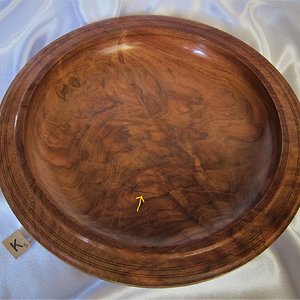@odie
Beautiful Jatoba crotch bowl. You said it started out at 20% MC and took 9 months to stabilize. For me if I have a bowl starting at 20% and rough I think it stable in a much shorter time. I usually check the weight once a week. When I get two weeks in a row with no change, I check it every day/couple of days for two weeks and if there is still no change it is stable to me. I have never to my knowledge had a roughed bowl take 9 months. I have mostly local woods vs. exotics if that is a difference. What do you call stable?
Hiya William.....

My process is a little different than yours in determining stabilization.....and, I find that, comparatively, I generally season my roughed bowls for a longer period of time than most other turners. Every turner must decide for themselves what process makes the most sense to their own particular needs.
My process is as follows: I weigh the roughed bowl monthly, and depending on the season of the year, an unchanged weight for either three or four months in a row indicate stabilization. I can see where my method might necessarily require additional time than your method.....but, it has been very successful for my purposes. Since this bowl blank was initially 20% MC, it is my usual method to anchorseal completely anything that meters over about 14% MC.....100% coverage. Some woods do release moisture slower than others, and the anchorseal slows it down further. This Jatoba crotch was fairly dense, especially because of the compressed grain in the crotch figure. I suspect a more straight grained piece of Jatoba might release moisture a little faster than this one did.
During the winter months, or times where there is a lot of rain, I've actually experienced a very slight weight gain in some bowls.....it's hard to predict which ones will gain weight, but others being processed at the same time might actually lose weight, or remain the same.
As you suspect, I've found that most domestic woods do stabilize quicker than most exotic woods, but there again, it's hard to predict what any one roughed bowl will log consecutive weights in their individual seasoning process.
I have had many bowls that have taken a year, or more to stabilize, and my world's record is 41 months for a Camphor Burl !!!!!

-----odie-----
Just in case anyone reading this thread is wondering, William and I are discussing this bowl of mine:
Finished 1/13/2022, Jatoba crotch. The crack was wide, and goes clear through. I tried to repair it with some clear epoxy with added brown dye. Decided I would not attempt to sell it, so it will become a gift to one of the church ladies. 11 1/2"...

www.aawforum.org

